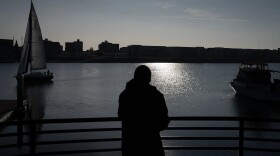Since we're coming up on the Fourth of July, and towns everywhere are preparing their better-than-ever fireworks spectaculars, we would like to offer this humbling bit of history. Back in the summer of 1962, the U.S. blew up a hydrogen bomb in outer space, some 250 miles above the Pacific Ocean. It was a weapons test, but one that created a man-made light show that has never been equaled — and hopefully never will. Here it is:
Some of the images in this video were until recently top secret. Peter Kuran of Visual Concept Entertainment collected them for his documentary Nukes In Space.
If you are wondering why anybody would deliberately detonate an H-bomb in space, the answer comes from a conversation we had with science historian James Fleming of Colby College.
"Well, I think a good entry point to the story is May 1, 1958, when James Van Allen, the space scientist, stands in front of the National Academy in Washington, D.C., and announces that they've just discovered something new about the planet," he told us.
Van Allen described how the Earth is surrounded by belts of high-energy particles — mainly protons and electrons — that are held in place by the magnetic fields.
Today these radiation belts are called Van Allen belts. Now comes the surprise: While looking through the Van Allen papers at the University of Iowa to prepare a Van Allen biography, Fleming discovered "that [the] very same day after the press conference, [Van Allen] agreed with the military to get involved with a project to set off atomic bombs in the magnetosphere to see if they could disrupt it."
Discover It, Then Blow It Up
The plan was to send rockets hundreds of miles up, higher than the Earth's atmosphere, and then detonate nuclear weapons to see: a) If a bomb's radiation would make it harder to see what was up there (like incoming Russian missiles!); b) If an explosion would do any damage to objects nearby; c) If the Van Allen belts would move a blast down the bands to an earthly target (Moscow! for example); and — most peculiar — d) if a man-made explosion might "alter" the natural shape of the belts.
The scientific basis for these proposals is not clear. Fleming is trying to figure out if Van Allen had any theoretical reason to suppose the military could use the Van Allen belts to attack a hostile nation. He supposes that at the height of the Cold War, the most pressing argument for a military experiment was, "if we don't do it, the Russians will." And, indeed, the Russians did test atomic bombs and hydrogen bombs in space.
In any case, says the science history professor, "this is the first occasion I've ever discovered where someone discovered something and immediately decided to blow it up."
Code Name: Starfish Prime
The Americans launched their first atomic nuclear tests above the Earth's atmosphere in 1958. Atom bombs had little effect on the magnetosphere, but the hydrogen bomb of July 9, 1962, did. Code-named "Starfish Prime" by the military, it literally created an artificial extension of the Van Allen belts that could be seen across the Pacific Ocean, from Hawaii to New Zealand.
In Honolulu, the explosions were front page news. "N-Blast Tonight May Be Dazzling: Good View Likely," said the Honolulu Advertiser. Hotels held what they called "Rainbow Bomb Parties" on rooftops and verandas. When the bomb burst, people told of blackouts and strange electrical malfunctions, like garage doors opening and closing on their own. But the big show was in the sky.
To hear eyewitness accounts of what it looked like, listen to our broadcast on All Things Considered by clicking the Listen button on the top of this page.
Copyright 2022 NPR. To see more, visit https://www.npr.org. 9(MDAzMjM2NDYzMDEyMzc1Njk5NjAxNzY3OQ001))






